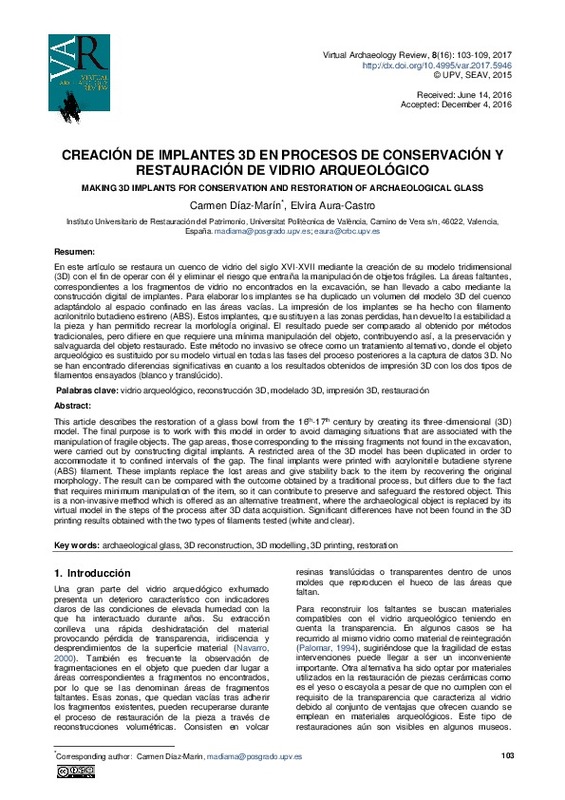JavaScript is disabled for your browser. Some features of this site may not work without it.
Buscar en RiuNet
Listar
Mi cuenta
Estadísticas
Ayuda RiuNet
Admin. UPV
Creación de implantes 3D en procesos de conservación y restauración de vidrio arqueológico
Mostrar el registro completo del ítem
Díaz-Marín, C.; Aura-Castro, E. (2017). Creación de implantes 3D en procesos de conservación y restauración de vidrio arqueológico. Virtual Archaeology Review. 8(16):103-109. https://doi.org/10.4995/var.2017.5946
Por favor, use este identificador para citar o enlazar este ítem: http://hdl.handle.net/10251/82757
Ficheros en el ítem
Metadatos del ítem
| Título: | Creación de implantes 3D en procesos de conservación y restauración de vidrio arqueológico | |
| Otro titulo: |
|
|
| Autor: | Díaz-Marín, Carmen | |
| Entidad UPV: |
|
|
| Fecha difusión: |
|
|
| Resumen: |
[EN] This article describes the restoration of a glass bowl from the 16th-17thcentury by creating its three-dimensional (3D)model. The final purpose is to work with this model in order to avoid damaging situations that are ...[+]
[ES] En este artículo se restaura un cuenco de vidrio del siglo XVI-XVII mediante la creación de su modelo tridimensional (3D)con el fin de operar con él y eliminar el riesgo que entraña la manipulación ...[+]
|
|
| Palabras clave: |
|
|
| Derechos de uso: | Reconocimiento - No comercial - Sin obra derivada (by-nc-nd) | |
| Fuente: |
|
|
| DOI: |
|
|
| Editorial: |
|
|
| Versión del editor: | https://doi.org/10.4995/var.2017.5946 | |
| Código del Proyecto: |
|
|
| Agradecimientos: |
El trabajo se ha desarrollado gracias al Programa del Plan Nacional de I+D+i 2008-2011 del Ministerio de Economía y Competitividad de España, Proyectos HAR2012-38391-C02-01 y HAR2012-38391-C02-02. También se ha desarrollado ...[+]
|
|
| Tipo: |
|









